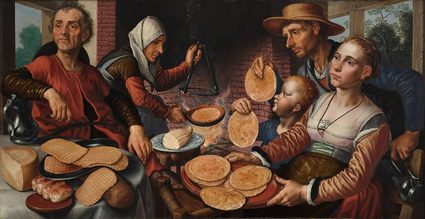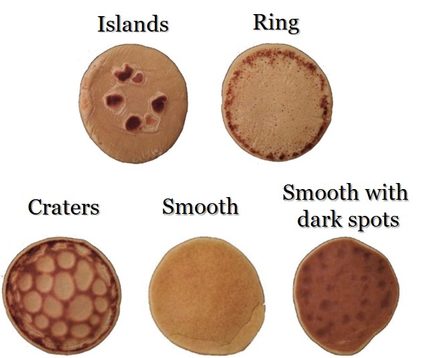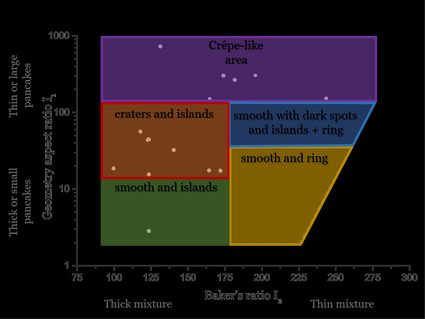Perfect Pancake Calculator
Have you ever thought that making pancakes may contribute to science? Is this a joke? Well, it turns out that it's all about physics, and what's even more important, it has a real influence on medical development, especially in glaucoma treatment. A little while ago, scientists from and the at Moorfields Eye Hospital have established interinstitutional cooperation to... make some pancakes. They provided mathematical theory, proofed by real kitchen experiments, that allows us to control the consistency of the batter.
We used this algorithm to test 15 unique recipes of pancakes from all over the world, with different sizes, thicknesses, and patterns. Our tool may be an excellent opportunity to prepare for the upcoming Shrove Tuesday, also known as Pancake Day Explore different types of pancakes with this calculator and find your perfect one!
Pancakes – flat cakes prepared from a starch-based batter and cooked on a hot surface. Who doesn't recognize them? We don't exactly know what the origin of the pancake is, but archaeological evidence suggests they were one of the earliest and most widespread cereal food eaten in ancient societies. Nowadays, pancakes are served worldwide (every inhabited continent has its own version of the pancake recipe) and are known under different names: pancakes, naleśniki, crêpes, and griddle cakes, to name a few. So, should we even ask ourselves if there is a universal recipe for a perfect pancake? With our perfect pancake calculator, you can now discover pancakes from 15 distinct regions, see how they look, learn how to make them, and what is the scientific description of their texture. Give it a try!
Did I hear that right? Pancakes and science? We're not kidding you. It turns out that making pancakes is all about physics, and what's even more important, it has a real influence on medical development, especially in treating glaucoma. Thus, it shouldn't be a surprise for you that physicists from University College London and specialists from the Biomedical Research Centre at Moorfields Eye Hospital have established interinstitutional cooperation to... cook some pancakes. Read on to learn more about the history of pancakes, the original recipes of pancakes, and how pancakes can be essential in healing glaucoma.
Pancakes around the world
It's hard to believe, but there are dozens of pancake recipes that differ in ingredients, size, and texture. Here, we have selected 15 types of pancakes from all around the world. How is it possible that the mixture of similar ingredients can result in so many distinct products? The answer lies behind the proportions covered in our proportion calculator and the way the batter is prepared and cooked. Depending on whether you prefer a small and thick or big and flat pancake, you can choose from the whole world below and decide which one will steal your heart today! We recommend trying each of them so that you can find out which is your favorite – our calculator will guide you with a step-by-step recipe.

The list of components consists of a few items: flour, milk or water, and eggs. We gave the amount of flour in grams, but we are also used to converting it into commonly used cups. A similar situation exists for oil, baking powder, and sugar. Remember that our perfect pancake calculator allows you to choose the unit you're more familiar with.
You may also have a grams to cups calculator that may help you to convert your measurements.
The history of pancakes – Shrove Tuesday
Pancakes – flat cakes prepared from a starch-based batter and cooked on a hot surface. Who doesn't recognize them? Pancakes have been among the most popular basic meals since the – 30,000 years ago. Their popularity comes from the simplicity of production – they are made of ingredients that are readily available in various regions. In ancient times they were made of wheat flour, curdled milk, honey, and olive oil and were probably cooked on rocks covered with grease. The well-preserved frozen mummy found in 1991 in the Italian Alps, Ötzi the Iceman, probably as his last meal 5,300 years ago.

The first crêpe-like pancake recipe was written in a 14th-century medieval by a French aristocrat, but the modern name pancake has its origin in 15th-century America, becoming commonly used since then. More recent pancake recipes can be found in 16th-century French and English cooking books, mostly made of flour, drawn butter, eggs, and white wine. Nowadays, we exchange our recipes, derived from different cultures, to be able to create the perfect pancake. Surprisingly, there are many ways to do so! How many of them have you already tried? Which suits you best?
Some countries celebrate a day before Easter by eating pancakes. In Iceland, people have Sprengidagur (Bursting Day), in Spain El Carnaval (Carnival), in Poland Tłusty Czwartek (Fat Thursday), and in the United Kingdom and the USA, Pancake Day or . All of them precede the fasting season of the 40 days of Lent in the Christian tradition that starts with Ash Wednesday. Shrove Tuesday falls precisely 47 days before Easter Sunday, and historically, it was the last opportunity to eat richer, fatty foods such as eggs and milk. On this day, Christians went to Church to confess and get absolved of their sins. In other words, to be shriven.
Are you anxiously awaiting pancake day? Use our Easter calculator to discover how long you need to wait.

How to make the perfect pancake?
That was a question that Prof. Ian Eames from the University College London Institute of Ophthalmology tried to answer together with and Dr. Yann Bouremel from the National Institute for Health Research, Biomedical Research Centre at Moorfields Eye Hospital. In their from 2016, they used a combination of kitchen experiments and mathematical theory to categorize pancakes based on patterns they take after cooking: islands, rings, craters, smooth or smooth with dark spots.

Scientists decided to prepare pancake batters using different ratios of ingredients and characterize pancakes' properties in terms of two quantities:
-
Geometry aspect ratio: I₁ = D³/V is a function of the diameter D of a pancake (obtained by pouring the batter in the center of a hot pan) to the volume V of the used batter. We get a higher value of I₁ for thin or large pancakes and less for a thick or small one.
-
Baker's ratio: I₂ = liquid_mass / flour_mass × 100 is the ratio of the mass of liquid (either milk or water) to the mass of flour, multiplied by 100. Interpretation of this metric is simple – the greater I₂, the thicker the batter is, the harder it is to spread on the pan.
After the exciting and undoubtedly delicious experiment, they managed to create the diagram as shown in the below figure. You can see there 5 distinct areas that correspond to the specific pattern that will appear on your pancake during cooking. As you probably already realized, our pancake calculator not only handles 15 pancake recipes but also shows to which group they were assigned by the authors of the article: How to Make the Perfect Pancake?

Here's a handy tip: Adding some yeast to the batter will help you get soft and fluffy pancakes! Use our yeast converter if you don't have the right type.
Why do pancakes have different consistency and patterns?
Everything starts from the batter and the proportion between flour and milk. The higher the amount of dry ingredients, the thicker the mixture, meaning it can't spread on the surface of the pan uniformly and form a perfectly round pancake. During the cooking, water from the batter evaporates, lifting a substance just a bit. If the batter is too thick, it will be moved upward unevenly, and therefore some parts will get fried more than others – that's how craters and islands are formed (a typical characteristic for Malaysian Lempeng Kelapa or American Griddle Cake).
Adding more milk to the mixture helps to obtain a thinner batter, which easily spreads on the pan. This time the consistency of batter helps the vapor to lift it evenly. You can get a smooth textured pancake with a "ring" at the edge. If the mixture is thin enough, the vapor actually goes through the substance, and although the surface of a pancake is smooth, it also consists of numerous dark spots. Further addition of milk dilutes the batter even more, and the final result resembles French Crêpes. To prepare any pancake, you need additional ingredients (or processes) to appropriately bind flour and milk into a batter, like proteins from eggs.
There are also a few types of pancakes that are made of water instead of milk, and sometimes there are no eggs included in the recipe. The most unusual one is Ethiopian Injera – the batter has to stand for some time to ferment. It's more like a kind of bread, but since it can be poured on the pan, it's formally classified as a pancake.
Pancakes save sight – glaucoma treatment
Surprisingly, the analysis of making perfect pancakes has a significant impact on the development of medicine. And that was the real side of the above experiment! Ophthalmologists use the fact that some of the pancakes can be investigated as a model of thin elastic sheets. They can be helpful to related to corneal transplants, retinal detachments or in glaucoma treatment. For the last one, the idea is to create a partially permeable membrane that helps to remove the excess water from the eye safely. That surplus of fluid causes the increase of the pressure in the eye, making eyesight worse and worse.
Research that considers the relation between the vapor permeability through the batter of different consistencies helps scientists design appropriate materials for future membranes in eye disease treatment. Now, when you are making the perfect pancakes, imagine you are participating in a big experiment to help people overcome their illnesses! Delicious and beneficial for humanity – that's how making pancakes works.
